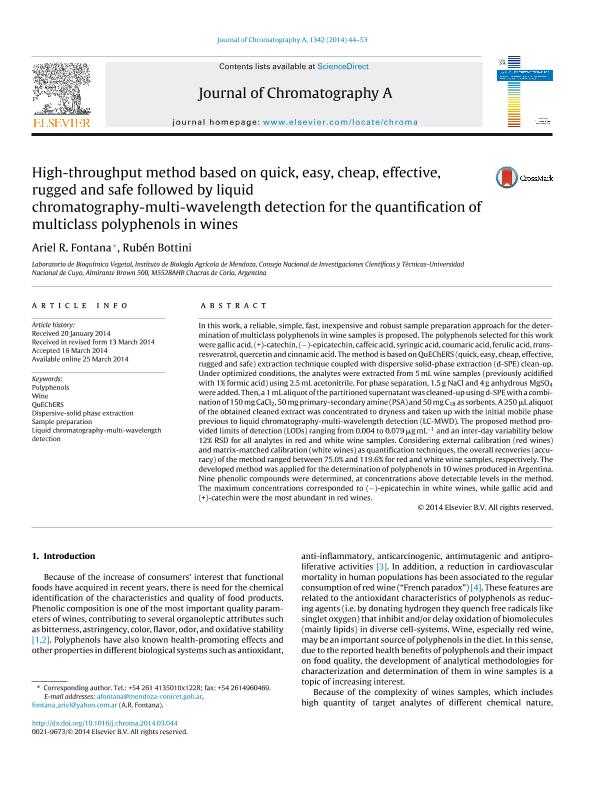Mostrar el registro sencillo del ítem
dc.contributor.author
Fontana, Ariel Ramón

dc.contributor.author
Bottini, Ambrosio Rubén

dc.date.available
2018-01-03T21:52:14Z
dc.date.issued
2014-03
dc.identifier.citation
Bottini, Ambrosio Rubén; Fontana, Ariel Ramón; High-throughput method based on quick, easy, cheap, effective, rugged and safe followed by liquid chromatography-multi-wavelength detection for the quantification of multiclass polyphenols in wines; Elsevier; Journal of Chromatography - A; 1342; 3-2014; 44-53
dc.identifier.issn
0021-9673
dc.identifier.uri
http://hdl.handle.net/11336/32252
dc.description.abstract
In this work, a reliable, simple, fast, inexpensive and robust sample preparation approach for the determination of multiclass polyphenols in wine samples is proposed. The polyphenols selected for this work were gallic acid, (+)-catechin, (-)-epicatechin, caffeic acid, syringic acid, coumaric acid, ferulic acid, trans-resveratrol, quercetin and cinnamic acid. The method is based on QuEChERS (quick, easy, cheap, effective, rugged and safe) extraction technique coupled with dispersive solid-phase extraction (d-SPE) clean-up. Under optimized conditions, the analytes were extracted from 5 mL wine samples (previously acidified with 1 % formic acid) using 2.5 mL acetonitrile. For phase separation, 1.5 g NaCl and 4 g anhydrous MgSO4 were added. Then, a 1 mL aliquot of the partitioned supernatant was cleaned-up using d-SPE with a combination of 150 mg CaCl2, 50 mg primary-secondary amine (PSA) and 50 mg C18 as sorbents. A 250 µL aliquot of the obtained cleaned extract was concentrated to dryness and taken up with the initial mobile phase previous to liquid chromatography-multi-wavelength detection (LC-MWD). The proposed method provided limits of detection (LODs) ranging from 0.004-0.079 µg mL-1 and an inter-day variability below 12 % RSD for all analytes in red and white wine samples. Considering external calibration (red wines) and matrix-matched calibration (white wines) as quantification techniques, the overall recoveries (accuracy) of the method ranged between 75.0 % and 119.6 % for red and white wine samples, respectively. The developed method was applied for the determination of polyphenols in 10 wines produced in Argentina. Nine phenolic compounds were determined, at concentrations above detectable levels in the method. The maximum concentrations corresponded to (-)-epicatechin in white wines, while gallic acid and (+)-catechin were the most abundant in red wines.
dc.format
application/pdf
dc.language.iso
eng
dc.publisher
Elsevier

dc.rights
info:eu-repo/semantics/openAccess
dc.rights.uri
https://creativecommons.org/licenses/by-nc-nd/2.5/ar/
dc.subject
Polyphenols
dc.subject
Wine
dc.subject
Quechers
dc.subject
Dispersive Solid-Phase Extraction
dc.subject
Sample Preparation
dc.subject
Liquid Chromatography-Multi-Wavelenght Detection
dc.subject.classification
Otras Ciencias Químicas

dc.subject.classification
Ciencias Químicas

dc.subject.classification
CIENCIAS NATURALES Y EXACTAS

dc.title
High-throughput method based on quick, easy, cheap, effective, rugged and safe followed by liquid chromatography-multi-wavelength detection for the quantification of multiclass polyphenols in wines
dc.type
info:eu-repo/semantics/article
dc.type
info:ar-repo/semantics/artículo
dc.type
info:eu-repo/semantics/publishedVersion
dc.date.updated
2018-01-03T20:01:27Z
dc.journal.volume
1342
dc.journal.pagination
44-53
dc.journal.pais
Países Bajos

dc.journal.ciudad
Ámsterdam
dc.description.fil
Fil: Fontana, Ariel Ramón. Consejo Nacional de Investigaciones Científicas y Técnicas. Centro Científico Tecnológico Conicet - Mendoza. Instituto de Biología Agrícola de Mendoza. Universidad Nacional de Cuyo. Facultad de Ciencias Agrarias. Instituto de Biología Agrícola de Mendoza; Argentina
dc.description.fil
Fil: Bottini, Ambrosio Rubén. Consejo Nacional de Investigaciones Científicas y Técnicas. Centro Científico Tecnológico Conicet - Mendoza. Instituto de Biología Agrícola de Mendoza. Universidad Nacional de Cuyo. Facultad de Ciencias Agrarias. Instituto de Biología Agrícola de Mendoza; Argentina
dc.journal.title
Journal of Chromatography - A

dc.relation.alternativeid
info:eu-repo/semantics/altIdentifier/url/http://www.sciencedirect.com/science/article/pii/S0021967314004555
dc.relation.alternativeid
info:eu-repo/semantics/altIdentifier/doi/http://dx.doi.org/10.1016/j.chroma.2014.03.044
Archivos asociados
